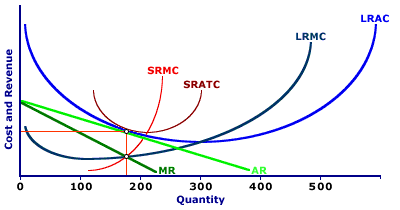
|
|
AGGREGATE SUPPLY SHIFTS: Changes in the aggregate supply determinants can shift either the short-run aggregate supply curve and the long-run aggregate supply curve. The mechanism is comparable to that for market supply determinants and market supply. We have two options -- an increase in aggregate supply and a decrease in aggregate supply. An increase in resource quantity or quality or a decrease in resource prices shift the aggregate supply curves to right. A decrease in resource quantity or quality or an increase in resource prices shift the aggregate supply curves to left.
Visit the GLOSS*arama
|
|


|

|
                           MONOPOLISTIC COMPETITION, LONG-RUN PRODUCTION ANALYSIS: In the long run, a monopolistically competitive firm adjusts plant size, or the quantity of capital, to maximize long-run profit. In addition, the entry and exit of firms into and out of a monopolistically competitive market eliminates economic profit and guarantees that each monopolistically competitive firm earns nothing more or less than a normal profit. Monopolistic competition is a market structure characterized by a large number of small firms producing similar but not identical products with relatively good resource mobility and extensive knowledge. These conditions mean that each firm has some degree of market control and faces a negatively-sloped demand curve. As such, the entry and exit of firms into and out of the industry eliminates economic profit. Moreover, the pursuit of profit maximization by individual firms facing negatively-sloped demand curves results in economic inefficiency.Long-Run Adjustment| Long-Run Adjustment |  |
The two adjustments undertaken by a monopolistically competitive industry in the pursuit of long-run equilibrium are:- Firm Adjustment: Each firm in the monopolistically competitive industry adjusts short-run production and long-run plant size to achieve profit maximization. This adjustment entails producing the quantity that equates marginal revenue',500,400)">marginal revenue to short run marginal cost for a given plant size as well as selecting the plant size that equates marginal revenue to long-run marginal cost.
- Industry Adjustment: Firms enter and exit a monopolistically competitive industry in response to economic profit and loss. If firms in the industry earn above-normal profit or receive economic profit, then other firms are induced to enter. If firms in the industry receive below-normal profit or incur economic loss, then existing firms are induced to exit. The entry and exit of firms causes the market price to change, which eliminates economic profit and loss, and leads to exactly normal profit.
Long-Run Equilibrium ConditionsThe combination of firm and industry adjustment results in two equilibrium conditions. The profit-maximizing condition is that marginal revenue is equal to marginal cost (both short run and long run). The zero economic profit condition is that price (and average revenue) is equal to average cost (both short run and long run).| MR = MC = LRMC | | P = AR = ATC = LRAC |
With marginal revenue (MR) equal to marginal cost (MC and LRMC), each firm maximizes profit and has no reason to adjust its quantity of output or plant size. With price (P) equal to average cost (ATC and LRAC), each firm in the industry is earning only a normal profit. Economic profit is zero and there is no economic loss.The six specific equilibrium conditions achieved by long-run equilibrium of monopolistically competitive industry are: (1) economic inefficiency (P > MC), (2) profit maximization (MR = MC), (3) market control (P = AR > MR), (4) breakeven output (P = AR = ATC), (5) excess capacity (ATC > MC), and (6) economies of scale (LRAC > LRMC). These conditions are only satisfied by the tangency of the negatively-sloped demand (average revenue) curve facing a monopolistically competitive industry and the economies of scale portion of the long-run average cost curve. This means that a monopolistically competitive firm does not achieve long-run economic efficiency. Key to these conditions is that they are NOT equal. Because price is not equal to marginal revenue in monopolistic competition average cost is not equal to marginal cost. The only production level in which average cost is equal to marginal cost (both short run and long run) is at the minimum efficient scale',500,400)">minimum efficient scale of production, the bottom of the long-run average cost curve. The only way to achieve this production level is the equality between price and marginal revenue. This equality is only achieved by perfect competition.

Recommended Citation:MONOPOLISTIC COMPETITION, LONG-RUN PRODUCTION ANALYSIS, AmosWEB Encyclonomic WEB*pedia, http://www.AmosWEB.com, AmosWEB LLC, 2000-2025. [Accessed: July 18, 2025].
Check Out These Related Terms... | | |
Or For A Little Background... | | | | | | | | | |
And For Further Study... | | | | | | | | | | | | |
Search Again?
Back to the WEB*pedia
|



|

|
|
In the early 1900s around 300 automobile companies operated in the United States.
|

|
|
"A winner is someone who recognizes his God-given talents, works his tail off to develop them into skills, and uses those skills to accomplish his goals. " -- Larry Bird, basketball player
|

|
BEA
Bureau of Economic Analisys
|

|
|
Tell us what you think about AmosWEB. Like what you see? Have suggestions for improvements? Let us know. Click the User Feedback link.
User Feedback
|


|


